UCCE Sonoma County along with other UC colleagues, recently received a grant to identify the impact of grazing on the frequency and severity of wildfire in California. The project will ask three specific questions:
- Does grazing reduce the likelihood of fires at the landscape scale?
- Does fire severity differ between grazed and ungrazed lands?
- What are the synergies and tradeoffs of grazing management as a tool to directly reduce wildfire risk?
Our results will be used to:
- Suggest to individual land owners the potential for grazing to reduce their risk of wildfire
- Influence policy makers to reduce barriers to grazing in California.

With the reduced frequency of wildfires, woody plant cover increased and shrublands and woodlands expanded (Miller et al., 1994). Burning was reintroduced around 1945, with the primary purpose to convert bushlands to grassland and to maintain the rangelands brush-free. An average of 67,000 acres of brush was burned annually under State permit from 1945 to 1951; and from 1951 through 1952, 133,000 acres burn annually (Biswell, 1954). With environmental conservation movement in the 1960s and 70s, controlled burning again was not favored and fire suppression was the referred management tool. This allowed ecosystems to accumulate more fuels that are prone to burning on a regular interval. Management practices can greatly affect a landscape's fuel amount and distribution. Fuel load, or biomass, is one of the most influential and easily manipulated fuel variation affective fire intensity (Strand et al., 2014). Livestock grazing is one management technique that has been shown to decrease fine fuel loading and subsequent wildfire severity (Davies et al., 2010).
Fire fuel treatments are designed to alter fuel conditions so that wildfire is easier to control and less destructive (Reinhardt et al., 2008). Cattle grazing primarily alters fuel conditions by reducing the amount of herbaceous fine fuels, whereas goat and sheep grazing can potentially also reduce the shrub component. Other fuel treatments that can be used to accomplish these same objectives include herbicides, mechanical treatments such as mowing, prescribed/controlled fires, or a combination of these treatments (Nader et al., 2007). Many studies have reviewed and describe factors affecting fuel treatment costs but studies specifically on rangelands are limited. Least cost fuel treatments will vary with conditions and objectives, but grazing alternatives appear to be cost-competitive especially if the objective is reduce fire fuel loads where mowing or a prescribed burn are potential alternatives (Strand et al., 2014).
Over the years, management has played a significant role in shaping California's rangelands. On a yearly basis, grazing can reduce the amount and alter the continuity of fine fuels, potentially changing wildfire fire spread and intensity (Stand et al., 2018). With changing climate conditions, it is now more critical than ever that grazing, as a fire fuel reduction tool, be scientifically quantified in order to demonstrate its use to landowners, managers and policy makers. California provides a unique opportunity to analyze how grazing effects wildfire trends due to the presences of long-term fire and climate datasets as well as diverse conditions under which grazing takes place. California is likely to see an increasing number of extreme fire danger days, almost doubling from current numbers over the next 50 years (Yoon et al, 2015).

The research project will use data from the past 30 years of wildfires across the whole state of California, along with data on climate, vegetation type, land ownership and biophysical variables to determine if grazed areas burned less frequently and/or with less severity than non-grazed areas. In addition, we will seek to identify trade-offs and synergies between grazing wildfire management. In areas where there is a high probability of ignition and the area is grazed, is there an optimum residual dry matter (RDM) to be managed for to reduce risk? Are there barriers to reaching the optimum RDM levels? Grazing by livestock is likely the most cost effective and practical treatment to apply across large landscapes scales to manage herbaceous fuels (Davies et al., 2015). Grazing can alter fuel characteristics of an ecosystem; however, little is known about the influence of grazing on fire, in particular ignition and initial spread and how it varies by grazing management differences (Davies, et al., 2017).
This project promotes the scientific significance andstrength of the UC network through collaboration of advisors and specialist to benefit California beef cattle producers and the rangelands they graze. It will address the priority of managing rangelands for multiple ecosystem services especially documenting the “why should we” and when to graze working landscapes to reduce fire severity in California. The research project will lead to more informed lands landowners, managers, policy makers and public on the importance of managing rangelands, through grazing. Research results will address the following issues:
Reducing Wildfire Risk. Increasingly severe wildfires are impacting an array of communities, including many lower income areas such as Lake and Mariposa Counties.
Wildfires increase air pollutants such as PM, CO and O3, amplifying problems that are already more severe in less affluent, inland areas. Wildfires put firefighter's lives at risk, reduce state funds available for other needs, jeopardize infrastructure, and increase insurance and utility costs. Improved wildland management for fire has already become a critical issue, with important implications for Low-Income Communities.
Sustaining Water Supply. Concerns were raised about the water supply that serves many counties during recent years up and down the state. East Bay Municipal Utility District rerouted staff from projects on district owned land in the Mokelumne watershed to burned areas above their reservoirs to help revegetate the watershed, and decrease erosion into Pardee Reservoir, drink water supply for the East Bay. Fires in Sonoma County about Lake Sonoma could have impacted the water source for both Sonoma and Marin County residence. In addition, the severity of wild fires in Santa Barbara and Ventura caused mud slides which lead to reductions in water quality and reservoir capacity. Improved wildland management will become increasingly important for maintaining California's water supply.
Maintaining Tourism Economy. Many of the state's rural areas, especially in the Sonoma, Santa Barbara, and Ventura depend heavily on tourism for local economies. The occurrence of fires impacted the number of tourist visiting, along with the commodities grown in those counties, i.e. grapes, vegetables, etc. The 2018 Ferguson Fire closed Yosemite National Park for an unprecedented two weeks, a large impact for a heavily touristy area around Yosemite and central California Foothill communities. Improved wildland management is becoming an important issue for maintaining tourism economies across rural California.
Increasing Grazing Lands. Many state lands are not currently managed to control fine fuels. Using livestock to manage them will open opportunities for more grazing lands, potentially allowing for greater flexibility of managing herds already in the state and providing opportunities for newer ranchers. In addition, controlling brush and reseeding an area has been documented to provide up to 2,000 lbs./acre in additional forage (Biswell, 1954), providing not only access to more forage for livestock, but also decreasing brush as a fuel. Both the coast range foothills and the Sierra Foothills can benefit from reduced brush encroachment.
Citations upon Request
Attached Images:
